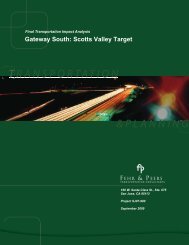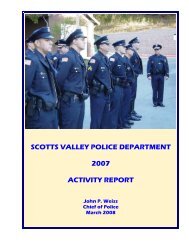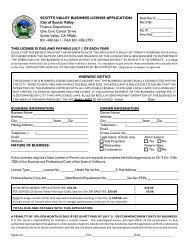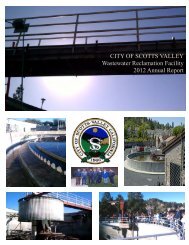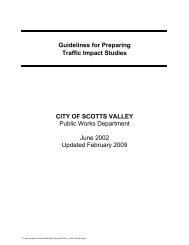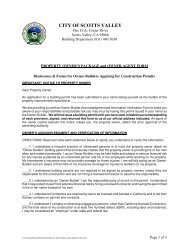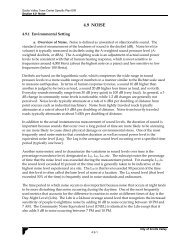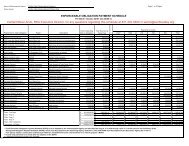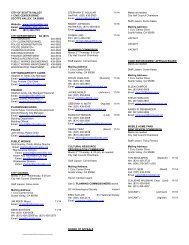Chapter 4: Housing Resources - City of Scotts Valley
Chapter 4: Housing Resources - City of Scotts Valley
Chapter 4: Housing Resources - City of Scotts Valley
You also want an ePaper? Increase the reach of your titles
YUMPU automatically turns print PDFs into web optimized ePapers that Google loves.
HOUSING RESOURCES <strong>Chapter</strong><br />
4<br />
A. Regional <strong>Housing</strong> Needs<br />
1. Regional <strong>Housing</strong> Needs<br />
This section analyzes resources available for<br />
the development, rehabilitation, and<br />
preservation <strong>of</strong> housing in <strong>Scotts</strong> <strong>Valley</strong>. This<br />
includes an evaluation <strong>of</strong> the <strong>City</strong>’s regional<br />
housing need, availability <strong>of</strong> land for new<br />
housing, the availability <strong>of</strong> financial resources<br />
to support housing activities, and the<br />
availability <strong>of</strong> administrative resources to<br />
assist the <strong>City</strong> in implementing housing<br />
programs.<br />
State law requires each jurisdiction when preparing its State-mandated<br />
<strong>Housing</strong> Element, to develop housing programs to meet its “fair share” <strong>of</strong><br />
housing needs for all income groups. This “fair share” concept seeks to<br />
ensure that each jurisdiction, to the extent feasible and appropriate, provides<br />
housing for its resident population, and those households who might<br />
reasonably be expected to reside within the jurisdiction, with a variety <strong>of</strong><br />
housing accommodations appropriate to their needs.<br />
The regional fair share determination process begins every five years with<br />
the State Department <strong>of</strong> Finance’s population projections for the State <strong>of</strong><br />
California and the many regions throughout the state. The State Department<br />
<strong>of</strong> <strong>Housing</strong> and Community Development (HCD) uses these projections to<br />
determine the amount and composition <strong>of</strong> housing need in different regions<br />
<strong>of</strong> California. The region’s housing need projections are determined in<br />
consultation with Council <strong>of</strong> Governments, which are designated public<br />
agencies which address regional planning in each region <strong>of</strong> the State.<br />
Once the regional housing need for Santa Cruz County and Monterey<br />
County is determined, the Council <strong>of</strong> Governments allocates a share <strong>of</strong> the<br />
region’s housing need to each jurisdiction. In the Monterey County and Santa<br />
Cruz County area, the agency responsible for assigning “fair share” housing<br />
targets to each community is the Association <strong>of</strong> Monterey Bay Area<br />
Governments (AMBAG). Local jurisdictions are then required, as part <strong>of</strong> the<br />
<strong>Housing</strong> Element process, to develop local programs to accommodate their<br />
share <strong>of</strong> housing need.<br />
Based upon Statewide population projections, HCD determined that 15,130<br />
housing units would address the region’s housing needs arising from 2009<br />
through 2014 due to population and employment growth.
Once basic housing need is calculated for the region, AMBAG is required to<br />
allocate the region’s total to each community within the AMBAG region. In<br />
doing so, AMBAG must take into account various planning factors. According<br />
to Section 65584 <strong>of</strong> the Government Code, these considerations are:<br />
<br />
<br />
<br />
<br />
<br />
<br />
<br />
<br />
Market demand for housing<br />
Employment opportunities<br />
Availability <strong>of</strong> suitable sites and public facilities<br />
Commuting patterns<br />
Type and tenure <strong>of</strong> housing<br />
Loss <strong>of</strong> units in assisted housing developments<br />
Over-concentration <strong>of</strong> lower income households<br />
Geological and topographical constraints<br />
A Technical Advisory Committee was formed to disaggregate the regional<br />
housing needs allocation into Monterey County and Santa Cruz County. In<br />
making its determination, the Technical Advisory Committee relied on<br />
AMBAG’s Population and Employment forecasts for the region, which is<br />
used for transportation planning purposes.
2. <strong>Scotts</strong> <strong>Valley</strong>’s <strong>Housing</strong> Need<br />
Once the region’s housing need was allocated to Santa Cruz and Monterey<br />
counties, each jurisdiction was allocated a share <strong>of</strong> the County’s need. To<br />
make this allocation, AMBAG determined the amount <strong>of</strong> household growth<br />
projected for each jurisdiction. The ratio <strong>of</strong> a jurisdiction’s versus the<br />
County’s projected household growth was then applied to the County’s total<br />
housing need.<br />
State law requires that AMBAG allocate housing unit goals in such a manner<br />
as to avoid and reduce the disproportionate concentration <strong>of</strong> lower income<br />
households in any one jurisdiction. To that end, AMBAG compared the<br />
existing household income distribution <strong>of</strong> each jurisdiction to the County.<br />
Based on the assumption that all cities should eventually provide the same<br />
affordability levels <strong>of</strong> housing.<br />
Chart 4-1 below summarizes the <strong>City</strong>’s allocation <strong>of</strong> the region’s housing<br />
needs by affordability level. Should the County’s lawsuit change the final<br />
allocation, the <strong>City</strong>’s <strong>Housing</strong> Element should be amended accordingly.<br />
Chart 4-1<br />
<strong>Scotts</strong> <strong>Valley</strong>’s Regional <strong>Housing</strong> Needs Production Goals<br />
Household<br />
Income Group<br />
Definition<br />
Affordability Level<br />
Income Range for<br />
a 4-person family<br />
Production<br />
Goals<br />
Very Low < 50% <strong>of</strong> County MFI Less than $43,500 42<br />
Low<br />
Moderate<br />
51%-80% <strong>of</strong> County<br />
MFI<br />
81-120% <strong>of</strong> County MFI<br />
$43,5001 to<br />
$69,600 32<br />
$69,6001 to<br />
$97,600 36<br />
Above Moderate 1201% + <strong>of</strong> County MFI Above $97,600 78<br />
Total 188<br />
The <strong>City</strong> is required to facilitate and encourage the production <strong>of</strong> new<br />
housing affordable to these various household income levels. For purposes<br />
<strong>of</strong> assignments, single-family homes and condominiums are only affordable<br />
to above-moderate-income households. Apartments rent at $900-$1,400 for<br />
a one-bedroom unit, $1,200 to $1,800 for a two-bedroom unit, and $1,500-<br />
$2,450 for a three-bedroom unit. Moderate-income households can afford<br />
most apartments. However, second units and guest houses rent for<br />
approximately $1,000 and are affordable to lower income households.
3. <strong>Housing</strong> Production<br />
During the time frame <strong>of</strong> January 1, 2000 to December 31, 2008 a total <strong>of</strong><br />
379 new housing units have been built in <strong>Scotts</strong> <strong>Valley</strong>. There are currently<br />
159 market rate units approved and 20 affordable units approved which have<br />
not been constructed because to the economic down turn. The following<br />
describes affordable housing built since 2000. Chart 4-3 on the next page<br />
summarizes the units counted toward the <strong>City</strong>’s Regional <strong>Housing</strong> Needs.<br />
Duplex <strong>Housing</strong>-College <strong>Housing</strong><br />
According to the 2000 Census, group quarters include university owned, oncampus<br />
and <strong>of</strong>f-campus housing for unmarried students, provided the dorm<br />
is restricted to students who do not have their families living with them. Six<br />
duplex units have been built at Bethany College as part <strong>of</strong> their Master Plan<br />
to produce a total <strong>of</strong> 22 duplex units. These duplexes, reserved for married<br />
families, qualify within this category and are therefore eligible for counting as<br />
independent housing units. College <strong>of</strong>ficials indicate that these family units<br />
rent below $1,000/month and are affordable to low income households.<br />
Triplex Units<br />
The <strong>City</strong> and Polo Ranch developers are working with Habitat for Humanity<br />
to build affordable units. The developers <strong>of</strong> the 41-unit Polo Ranch project<br />
are, pursuant to a development agreement, proposing 2 triplexes consisting<br />
<strong>of</strong> 4 low income units and 2 very low income units. The <strong>City</strong> has approved<br />
the affordable housing project, the Affordable <strong>Housing</strong> Subcommittee has<br />
negotiated with the applicant to provide a build-ready site to Habitat for<br />
Humanity, and the <strong>City</strong> staff are currently reviewing the draft EIR. The project<br />
is anticipated to begin later in 2009 and be completed in 2010.<br />
Apartments<br />
The Bay Tree Apartments, Acorn Apartments, Kelly Court, and one small<br />
other project provide 70 new apartments, with some affordable to low and<br />
moderate income households. Acorn provides 4 low income income units<br />
and Bay Tree provides 5 low income and 4 moderate income units restricted<br />
for 30 years as a condition for receiving RDA assistance. Kelly Court is<br />
building an 11-unit project in the Redevelopment Project Area and has built<br />
through a developer agreement, to deed restrict 3 low-income apartments as<br />
part <strong>of</strong> a vertical mixed-use project onsite.
Second Units<br />
The <strong>City</strong> has facilitated the development <strong>of</strong> second units over the planning<br />
period by the following: 1) reducing development standards; 2) permitting<br />
them by right; and 3) reducing the impact fee from $14,321 to $9,394. Since<br />
2000, the <strong>City</strong> has approved the construction <strong>of</strong> six second units in the<br />
community. Based on interviews with applicants and a review <strong>of</strong> current rents<br />
cited in the Sentinel, second units are generally charging rents comparable<br />
with apartments, which are affordable to moderate income households.<br />
Single-Family Attached<br />
Several single-family projects were built within the boundaries <strong>of</strong><br />
Redevelopment Project Areas and were therefore required to fulfill a 15%<br />
inclusionary requirement as part <strong>of</strong> State law. The Bluebonnet Lane project<br />
includes 31 condos (near the <strong>Scotts</strong> <strong>Valley</strong> Senior Center) and provides 2<br />
low-income and 3 moderate-income units restricted until 2048. The Torrey<br />
Oak project (11-unit condominium project on Mt. Hermon Road and La<br />
Cuesta Drive) set aside 1 low-income unit and 1 moderate income unit as<br />
restricted until 2036. One additional affordable condominium unit has also<br />
been built. 48 new units were approved on Bluebonnet in 2008 and will<br />
provide 6 new affordable units.<br />
Chart 4-3 summarizes the <strong>City</strong>’s regional housing needs requirement,<br />
housing projects built and approved, and the remainding requirement that<br />
would need to be fulfilled through the designation <strong>of</strong> adequate sites.<br />
Chart 4-2<br />
<strong>Housing</strong> Production in <strong>Scotts</strong> <strong>Valley</strong><br />
January 2000 - December 2008<br />
Affordability <strong>of</strong> Units<br />
<strong>Housing</strong> Built/Approved<br />
Lower<br />
Income<br />
Moderate<br />
Above<br />
Moderate<br />
Total<br />
- Single-Family Detached 0 3 188 191<br />
- Duplexes/Triplexes 15 0 34 49<br />
- Apartments (5+ units) 10 7 56 73<br />
- Second Units 6 0 0 6<br />
- Condos/Townhomes 4 3 53 60<br />
Total 35 13 331 379<br />
B. <strong>Housing</strong> Opportunity Sites
This section analyzes the remaining housing need and where the <strong>City</strong> will<br />
designate sites that will have zoning and development standards,<br />
infrastructure and public facilities in place to accommodate the construction<br />
<strong>of</strong> new housing during the planning period.<br />
1. <strong>Housing</strong> Sites Planned for Residential Uses<br />
Based on the <strong>City</strong>’s land inventory, the <strong>City</strong> Council has proposed the<br />
following sites to meet the remainder <strong>of</strong> the RHNP. Chart 4-4 lists each site,<br />
the Assessor’s parcel number, acreage, density assumption, and affordability<br />
level.<br />
Each site has specific lot sizes, general plan land use and zoning<br />
designations, allowable density, and other attributes. The site criteria and<br />
ability to facilitate and encourage the construction <strong>of</strong> affordable housing are<br />
outlined below:<br />
<br />
<br />
<br />
Above-Moderate income. Residential sites which allow for single-family<br />
homes (e.g., such as R-R, R-1, etc.) are considered affordable to abovemoderate<br />
income housing based on earlier sales prices.<br />
Moderate income. Sites smaller than 1 1/2 acres, zoned for high density<br />
(9 to 15 units/acre), and typically could have apartments would facilitate<br />
moderate-income housing or sites with confirmed affordability<br />
restrictions.<br />
Lower income. Sites 1.5 acres and larger, either individually or through<br />
consolidation, with a land use designation allowing up to 20 units per<br />
acre, or sites with confirmed affordability restrictions.<br />
Town Center Specific Plan<br />
The <strong>City</strong> <strong>of</strong> <strong>Scotts</strong> <strong>Valley</strong> approved a specific plan and programmatic<br />
Environmental Impact Report for the development <strong>of</strong> a town center on<br />
approximately 15 acres along Mt. Hermon Road which was previously the<br />
old Skypark Airport. The Programmatic Environmental Impact Report and<br />
Specific Plan anticipate a total <strong>of</strong> 300 new housing units within the Specific<br />
Plan area. 100 <strong>of</strong> the units would be a stand-alone housing project and 200<br />
units would be part <strong>of</strong> the mixed use development in the town center core<br />
area. This project is within the <strong>City</strong>’s Redevelopment Agency which requires<br />
that 15% <strong>of</strong> the units be affordable resulting in 45 new affordable units.<br />
In addition to the 15% required affordable units, the nature <strong>of</strong> the housing in<br />
the mixed use core <strong>of</strong> the Town Center should result in additional affordable<br />
housing opportunities being provided.<br />
College <strong>Housing</strong><br />
Bethany College comprises 80 acres <strong>of</strong> land set in riparian and slope areas.<br />
Bethany’s Master Plan proposes 28 units <strong>of</strong> married student housing, 36<br />
multi-family units along Bethany Loop, and 30 dorm units. College <strong>of</strong>ficials
indicate that all units will be rented to lower income households.<br />
Development <strong>of</strong> duplexes have already begun with six units built to date.<br />
Bethany apartments and dorm units cannot proceed until several issues are<br />
addressed: 1) proper environmental review has occurred; 2) the sites receive<br />
a water allocation; and 3) a secondary access road is built from <strong>Scotts</strong> <strong>Valley</strong><br />
Drive to Bethany Drive to Canham Road to address fire safety concerns.<br />
Second Units<br />
The <strong>City</strong> has facilitated the development <strong>of</strong> second units over the planning<br />
period by the following: 1) reducing development standards; 2) permitting<br />
them by right; and 3) reducing the impact fee from $14,321 to $9,394. Since<br />
2000, the <strong>City</strong> has approved six second units in the community. The <strong>City</strong> also<br />
updated its accessory dwelling unit ordinance for consistency with new state<br />
law. Since 2000, six accessory units have been built. Based on the market<br />
for second units in Santa Cruz, <strong>Scotts</strong> <strong>Valley</strong> estimates that a total <strong>of</strong> 25<br />
second units may be built from the 2000 to 2008 planning period. Second<br />
units are anticipated to be affordable to lower income households.<br />
Old Quarry Site<br />
<strong>Scotts</strong> <strong>Valley</strong> is home to an abandoned 16-acre quarry site and an adjacent<br />
vacant site used for outdoor trailer sales. The sites are vacant and<br />
substantially underutilized, designated as commercial (C-S) and rural<br />
residential (R-R), but could accommodate substantial new housing on both<br />
sites. However, full site development is contingent upon addressing potential<br />
environmental constraints, such as riparian habitat, sensitive species (e.g.,<br />
the Mt. Hermon June Beetle and silver leaf manzanita), slope and<br />
topography, and view sheds, as well as the potential for fossils and<br />
paleontological resources. In March 2004, the <strong>City</strong> Council approved a<br />
quarry remediation plan and allowance <strong>of</strong> commercial and residential uses<br />
on 6.26 acres <strong>of</strong> the site. The 2.26-acre portion fronting <strong>Scotts</strong> <strong>Valley</strong> Drive is<br />
intended as vertical mixed use; the 4 acres in back <strong>of</strong> the frontage is<br />
intended as very high density residential only. The six acres <strong>of</strong> developable<br />
land have been approved for 94 multiple-family units <strong>of</strong> which 14 will be<br />
affordable in an overall mixed residential-commercial use setting.<br />
Gateway South Specific Plan<br />
The Gateway South Specific Plan is an adopted plan for the area located at<br />
the southern main entrance to the <strong>City</strong> at Highway 17 and Mt. Hermon Road.<br />
Some <strong>of</strong> the Plan area is located in the Redevelopment Project Area.<br />
Specific Plan policies encourage a range <strong>of</strong> housing types and development<br />
configurations. This Specific Plan area is occupied by a new 180-room hotel,<br />
41 apartments (including 9 affordable units), and 20 townhomes. The Plan
anticipates 133 total units with a minimum <strong>of</strong> 21 units being affordable. The<br />
Specific Plan area has seven vacant residential sites zoned RV-H, and one<br />
site zoned C-S which allow high density mixed use by right.<br />
<strong>Scotts</strong> <strong>Valley</strong> Drive, North <strong>of</strong> Dunslee<br />
Two other sites along <strong>Scotts</strong> <strong>Valley</strong> Drive were selected for new housing.<br />
North <strong>of</strong> Dunslee, this 9.5-acre vacant site slopes up to the west, and is a<br />
candidate for a density transfer. Of the 9.5 acres, 2 acres are considered<br />
developable –one-acre is zoned C-S and one acre is zoned R-R. The site<br />
has been rezoned C-S and allows up to 20 units per acre, yielding 40 units<br />
for this site. Greater densities and total units may be possible pursuant to a<br />
density transfer.<br />
<strong>Scotts</strong> <strong>Valley</strong> Drive, North <strong>of</strong> Shell Station<br />
Additional sites for housing are available along <strong>Scotts</strong> <strong>Valley</strong> Drive. North <strong>of</strong><br />
the Shell station on the east side <strong>of</strong> <strong>Scotts</strong> <strong>Valley</strong> Drive are three vacant<br />
parcels totaling 3.8 acres, <strong>of</strong> which 2.0 acres are developable. These three<br />
sites are all contiguous to one another and the <strong>City</strong> is actively encouraging<br />
their consolidation to provide the preconditions for a quality residential<br />
product. The sites were rezoned to R-M in 2007. Together, this site could<br />
yield 30 housing units.<br />
Bluebonnet Lane<br />
The Bluebonnet Lane site is a 2.5-acre site adjacent to the Cavarallo Transit<br />
Center. The site is vacant, relatively flat, and has no environmental<br />
constraints. The site is located in the <strong>City</strong>’s Redevelopment Project Area and<br />
requires that 15% <strong>of</strong> the units be affordable. Along the western half <strong>of</strong> the<br />
site, there is an opportunity for higher density residential uses which would<br />
be within walking distance <strong>of</strong> public and commercial uses, such as the<br />
Community Center, Transit Center, Senior Center, and Kings Village<br />
Shopping Center. The <strong>City</strong> rezoned this site as R-VH in 2007 and approved<br />
a 48 unit project with 6 affordable units in 2008. It is hoped construction will<br />
start within the next year.<br />
Glen Canyon<br />
The <strong>City</strong> has identified 3.6 acres at the corner <strong>of</strong> Glen Canyon/Mt. Herman<br />
Road rezoned the property to C-S with high density residential permitted as<br />
part <strong>of</strong> a mixed use project. The particular site was previously approved for<br />
<strong>of</strong>fice buildings, which are no longer desired. The site is a vacant lot is<br />
between Oak Creek Boulevard and the Shell Gas Station and backs up to<br />
residential uses. There are no environmental or topographical constraints.
Chart 4-3 on the next page summarizes these sites and their credit toward<br />
the 2009-2014 Regional <strong>Housing</strong> Needs Plan. Taken together, these sites<br />
will yield up to 106 units potentially affordable to lower income households<br />
and 77 units affordable to moderate-income households, exceeding the<br />
remaining RHNP.<br />
CHART 4-3<br />
Regional <strong>Housing</strong> Needs Plan<br />
RHNP Progress<br />
Maximum Units<br />
Lower Moderate Upper<br />
o<br />
u<br />
Remainder (RHNP-Sites) -0- -0- -0-<br />
Source: <strong>City</strong> <strong>of</strong> <strong>Scotts</strong> <strong>Valley</strong>, 2009<br />
* Surplus <strong>of</strong> lower income sites will cover the deficit in moderate income units<br />
Total<br />
Units<br />
Regional <strong>Housing</strong> Goals 74 36 78 188<br />
Approved – Bluebonnet Lane 6 42 48<br />
Approved – Pennicle View 20 20<br />
Approved – Quarry Site 7 7 80 94<br />
Approved – Greenhills Road 17 17<br />
<strong>Housing</strong> Sites<br />
Remainder 61 29 0 9<br />
Bethany College 22 22<br />
Second Units 5 5<br />
Town Center Specific Plan 45 55 200 300<br />
Gateway South Specific Plan 21 22 93 136<br />
Erba Lane 11 11<br />
<strong>Scotts</strong> <strong>Valley</strong> Dr/No. <strong>of</strong> Dunslee 6 34 40<br />
<strong>Scotts</strong> <strong>Valley</strong> Drive, No. Mt.<br />
Hermon<br />
7 33 30<br />
Glen Canyon 2 8 10<br />
Total <strong>Housing</strong> Sites 121 84 528 733<br />
Chart 4-4 provides a complete description <strong>of</strong> each parcel, its attributes, and<br />
assumed suitability to facilitate housing affordable to households <strong>of</strong> different<br />
income levels, including lower income. It is anticipated that lots in the<br />
Gateway area and <strong>Scotts</strong> <strong>Valley</strong> Drive will be consolidated to provide for<br />
better design.<br />
LOCATION APN SIZE ZONING<br />
Chart 4-4<br />
<strong>Housing</strong> Sites for the Regional <strong>Housing</strong> Needs<br />
DENSIT<br />
Y<br />
LOW<br />
UNITS<br />
MARKET<br />
UNITS<br />
CURRENT<br />
USE<br />
Bethany 23-022-08 333.0 P/QP open 22 Various
2 nd units various various -- -- 5 Various<br />
Town Center<br />
Quarry<br />
See specific<br />
plan 17 acres various various 45 255 Vacant<br />
22-451-<br />
04,10 6.26 C-S* 15-20 14 80 Vacant<br />
Gateway 22-151-05 1.72 R-VH 15-20 5 29 Under<br />
Gateway 21-321-04 2.03 R-VH 15-20 6 34 Vacant<br />
Gateway 22-151-03 1.10 R-VH 15-20 3 17 Under<br />
Gateway 22-151-04 0.57 R-M 8 1 3 Vacant<br />
Gateway 22-151-11 1.10 R-VH 20 3 17 Under<br />
Gateway 22-151-07 .50 R-VH 15-20 2 8 Under<br />
Gateway 22-151-08 .48 R-VH 15-20 1 7 Under<br />
Erba Lane 22-481-15 0.75 R-H 15 0 11 Vacant<br />
Greenhills<br />
Pinnacle<br />
View<br />
24-211-01<br />
&02 43 acres R-R-2.5 2.5 0 17<br />
21-281-<br />
01,02,05 &<br />
06 2 acres R-VH 15-20 0 20<br />
Vacant<br />
Vacant<br />
Bluebonnet 22-211-92 2.48 R-VH 15-20 6 42 Vacant<br />
Dunslee 22-451-01 2.00 C-S* 15-20 6 34 Vacant<br />
<strong>Scotts</strong> <strong>Valley</strong><br />
Drive, no. <strong>of</strong><br />
Mt Herman*<br />
22-162-69 2.30 R-M 8 5 25 Vacant<br />
22-162-74 .01 R-M 8 0 0 Vacant<br />
22-132-48 0.94 R-M 8 0 0 Vacant<br />
Glen Canyon 22-162-76 3.6 C-S* 15-20 2 8 Vacant<br />
TOTAL 126 607 733
It is anticipated that the
C. <strong>Resources</strong> for Addressing <strong>Housing</strong> Needs<br />
The <strong>City</strong> <strong>of</strong> <strong>Scotts</strong> <strong>Valley</strong> has access to a variety <strong>of</strong> existing and potential<br />
funding sources available for affordable housing activities. They include<br />
programs from local, state, federal and private resources. In addition,<br />
various public and nonpr<strong>of</strong>it agencies are available to assist the <strong>City</strong> in<br />
implementing its housing policies and programs. The following describes the<br />
financial and administrative resources available to the <strong>City</strong> <strong>of</strong> <strong>Scotts</strong> <strong>Valley</strong>.<br />
1. Financing <strong>Resources</strong><br />
Redevelopment <strong>Housing</strong> Set-Aside<br />
State law requires all redevelopment agencies, including <strong>Scotts</strong> <strong>Valley</strong><br />
Redevelopment Agency (RDA) to set aside a minimum <strong>of</strong> 20% <strong>of</strong> all tax<br />
increment revenue generated from redevelopment projects for affordable<br />
housing. The Agency’s set-aside funds must be used for activities that<br />
increase, improve, or preserve the supply <strong>of</strong> affordable housing. <strong>Housing</strong><br />
developed under this program must remain affordable to the targeted income<br />
group for at least 55 years for rentals and 45 years for ownership housing.<br />
Approximately $1,000,000 annually in housing set-aside funds is expected<br />
to be generated for housing-related purposes. Using set-aside funds, the<br />
RDA presently funds the First Month’s Rent/Security Deposit Program<br />
($78,000 annually), $500,000 for subsidies for completed affordable housing<br />
projects, $500,000 for loans and advances for affordable housing (e.g.,<br />
Bluebonnet and Windward Place), $45,000 for monies to support the Santa<br />
Cruz <strong>Housing</strong> Authority, as well as other programs. The RDA has purchased<br />
an affordable housing parcel in the Town Center Specific Plan area for the<br />
development <strong>of</strong> affordable units and expects to joint venture the development<br />
<strong>of</strong> the mixed use housing in the Town Center core using RDA <strong>Housing</strong><br />
Funds.<br />
Proposition 46 Funds<br />
In 2002, California voters approved a record $2.1 billion bond to address the<br />
State’s affordable housing crisis. The bond is the State’s first in twelve<br />
years. According to HCD, the housing bond will create up to 22,000<br />
permanently affordable homes for rent; enable more than 65,000 families to<br />
purchase their own homes; provide housing assistance for 12,000 to 24,000<br />
farmworker families; and underwrite 20 million shelter bed days for homeless<br />
people. These bond funds will be available on a competitive basis and<br />
represent a major opportunity to leverage local monies for affordable<br />
housing.<br />
2. Administrative <strong>Resources</strong>
Described below is a sample <strong>of</strong> public and non-pr<strong>of</strong>it agencies that have<br />
been involved in housing activities in north Santa Cruz County. These and<br />
other agencies play important roles in meeting the housing needs <strong>of</strong> the<br />
community. In particular, they are or can be involved in the improvement <strong>of</strong><br />
housing stock, expansion <strong>of</strong> affordable housing opportunities, preservation <strong>of</strong><br />
affordable housing, and/or provision <strong>of</strong> housing assistance to those in need.<br />
<strong>Scotts</strong> <strong>Valley</strong> Redevelopment Agency<br />
The <strong>Scotts</strong> <strong>Valley</strong> Redevelopment Agency has played an active role in<br />
meeting the housing needs <strong>of</strong> the community. Since 1995, the Agency<br />
contributed housing set-side funds to support the development <strong>of</strong> 71<br />
affordable housing units including the recently constructed Baytree and<br />
Acorn apartment projects. The Agency has also provided funds to increase<br />
home purchase opportunities through the Silent Second Mortgage Program.<br />
<strong>Housing</strong> Authority <strong>of</strong> the County <strong>of</strong> Santa Cruz<br />
The <strong>Housing</strong> Authority <strong>of</strong> the County <strong>of</strong> Santa Cruz was created to provide<br />
housing assistance for the County's lower- and moderate- income residents.<br />
The <strong>Housing</strong> Authority administers the Section 8 rental assistance program<br />
and manages public housing developments. The <strong>Housing</strong> Authority also<br />
administers various programs, including the Mortgage Credit Certificate<br />
Program. Currently 45 <strong>Scotts</strong> <strong>Valley</strong> households receive Section 8 rental<br />
assistance through the County, and 15 low and moderate income<br />
households have received financial assistance through the MCC program.<br />
Community Action Board <strong>of</strong> Santa Cruz County, Inc. (CAB)<br />
CAB conducts, administers and coordinates community programs to combat<br />
poverty in Santa Cruz and Monterey Counties. CAB <strong>of</strong>fers several programs:<br />
energy/utility payment assistance; the Shelter Project (housing and homeless<br />
services); job training and employment services; immigration assistance; and<br />
community building. Under the Shelter Project, CAB operates five services<br />
for homeless people or those at risk <strong>of</strong> homelessness, including: <strong>Housing</strong> for<br />
Medical Emergencies Program, Motel Vouchers for homeless persons facing<br />
emergency medical situations, Emergency Rent Assistance to prevent<br />
eviction, and a Message Center (voice mail), Shelter Hotline, and Resource<br />
Guide.<br />
Front Street, Inc.<br />
Front Street, Inc. (FSI) is the primary provider <strong>of</strong> social rehabilitation facilities<br />
throughout Santa Cruz County. FSI has been in operation since 1990, when<br />
it took over the 47-bed Front Street board and care facility in Santa Cruz.<br />
FSI also operates the 15-bed Darwin House for persons with mental illness<br />
and/or chemical dependency. FSI is committed to supporting its clients at the<br />
highest level <strong>of</strong> independence possible and provides both board and care<br />
and independent housing with wrap-around services.
Habitat for Humanity<br />
Habitat for Humanity is a non-pr<strong>of</strong>it, Christian organization dedicated to<br />
building and rehabilitating affordable housing for lower income families.<br />
Habitat builds and repairs homes with the help <strong>of</strong> volunteers and partner<br />
families. Habitat homes are sold to partner families at no pr<strong>of</strong>it with<br />
affordable, no-interest loans. Volunteers, churches, businesses, and other<br />
groups provide most <strong>of</strong> the labor for the homes. Government agencies or<br />
individuals typically donate land for new homes. Habitat Santa Cruz has built<br />
24 homes since 2000 and is developing 6 single-family homes in <strong>Scotts</strong><br />
<strong>Valley</strong>.<br />
Mid-Peninsula <strong>Housing</strong> Coalition (MPHC)<br />
Mid-Peninsula is an established regional non-pr<strong>of</strong>it organization involved in<br />
the development, management, acquisition and rehabilitation <strong>of</strong> affordable<br />
rental housing. MPHC primarily develops affordable family and senior rental<br />
apartments. Since it was founded in 1971, MPHC has developed over 3,700<br />
affordable housing units in six northern California counties. MPHC has also<br />
rehabilitated over 300 units in blighted neighborhoods. MPHC has been<br />
involved in the preservation <strong>of</strong> affordable housing units that are at risk <strong>of</strong><br />
converting to market rate uses. MPHC built the Emerald Hill project, a 46-unit<br />
apartment project that provides housing for very-low-income households.<br />
First Community <strong>Housing</strong><br />
FCH is a 501 [c] [3] non-pr<strong>of</strong>it, public benefit developer committed to building<br />
high quality, sustainable, affordable housing and passing energy savings<br />
along to our tenants. FCH locates developments adjacent to transit corridors<br />
and provides free "eco-passes" to all our tenants, allowing free bus and light<br />
rail use throughout Santa Clara County. FCH develops the following housing<br />
types: family housing, senior housing, SROs, live/work l<strong>of</strong>ts, and mixed use<br />
developments. Since its founding in 1986, FCH has developed 800 units<br />
with another 200 units in development. FCH’s incorporation <strong>of</strong> green building<br />
materials has been featured in numerous green building journals, the AIA<br />
Memo and Global Green USA Case Study.





